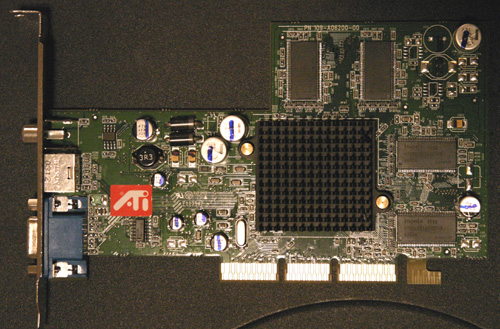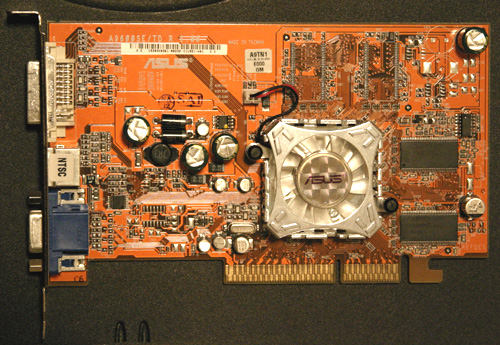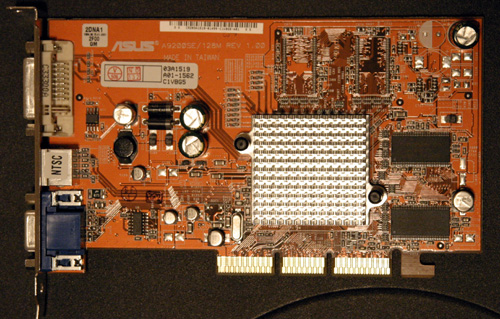Fall 2003 Video Card Roundup, Part 4: Budget Shootout
by Derek Wilson on December 15, 2003 11:14 AM EST- Posted in
- GPUs
The Budget Cards
The NVIDIA GeForce FX 5200 Ultra has been around for a while, as has the ATI Radeon 9200. The newcomers in this review are the part of the SE line of Radeons from ATI: the 9600 SE and 9200 SE.
NVIDIA GeForce FX 5200 Ultra
We used a reference model of the GeForce FX 5200 Ultra. We note that this is the only card in the budget group to require power via a molex connector from the power supply.

This is an ATI designed Radeon 9200 card. This card is stated as being “DirectX 9.0 Compatible” as is its little brother, the 9200 SE. This is a step down from other current generation ATI cards, which claim that they are “DirectX 9.0 Compliant”. We will find out exactly what this means for games in our performance analysis.

ATI Radeon 9600 SE

ATI Radeon 9200 SE
The two SE models that we used are designed by ASUS . The difference between these cards and their counterparts is simple: the memory bus is cut from 128bits wide down to 64bits wide. This has a different impact on different games, lowering performance at the most on memory bandwidth intensive applications. Other than that difference, these cards are set up the same as existing non-pro 9600 cards and 9200 cards.
The test system that we used is the same as used in Part 2 and Part 3 of our roundup series:
AMD Athlon64 FX51
1GB DDR400 (2x512) RAM
nForce3 Motherboard
Without further ado, we bring you gaming performance.










22 Comments
View All Comments
cristic - Tuesday, December 16, 2003 - link
for #10: yes it would be, also like a 9800non-pro against a 9600XT and 9700 and 9700proIf I should buy a low-end card right now I would go with a 4200... heck I own one, since god know when! (:
DAPUNISHER - Tuesday, December 16, 2003 - link
Since using AA/AF with budget cards in the vast majority of games just isn't doable with playable frame rates, I have to agree the ti4200 is still the king :) people who bought G4 ti4200 cards back in a day are only 2nd to 9700pro owners in bang for the buck over the long haul IMHO :)Jeff7181 - Tuesday, December 16, 2003 - link
I'm curious as to why the 9800 Pro was included in the results... it's hardly a budget card. I understand it gives an indication of how a budget card performs when compared to the best. But why isn't there any nVidia high end cards? If someone doesn't like ATI and wants to know how a 5700 Ultra compares to a 5900 non-ultra, wouldn't that be a useful tidbit to have here?nastyemu25 - Tuesday, December 16, 2003 - link
lol@#7i concur.
Maringer - Tuesday, December 16, 2003 - link
Personally, I find it pretty amazing that the 9600SE can beat the 5200Ultra in so many of the benchmarks seeing as it has less than a third of the memory bandwidth in comparison.It leads me to think that it is a hell of a waste to use this chip on such a low-spec card. I suppose the market is calling for it though.
merlocka - Tuesday, December 16, 2003 - link
To everyone above who is griping about the test setup and/or the conclusion, I agree 100%. Who the heck does Derek think he is testing these cards with a PC which won't cause an artificial bottleneck?Is he trying to provide accurate results or something?
I can't believe I just paid money to read this article... from now on, I'm going to buy every single piece of hardware that is out there and test them all myself on a test PC which I buy so I know EXACTLY which $50 video card to buy.
Or perhaps I'll quit b!tching and just read reviews on websites who offer content for basically free.
TrogdorJW - Tuesday, December 16, 2003 - link
Also, the article shows quite clearly that these three budget cards are complete garbage and should all be avoided like the plague. That's useful.9600SE: $99 or more
9200SE: $46.50 or more
5200 Ultra: $109 or more
5200: $63 or more (but it's even slower than the 5200 Ultra)
GeForce4 Ti4200: $75 or more
I got those prices from Newegg.com, except for the Ti4200 - it's being phased out, so you'd better act fast if you want one! So, if you really want a faster graphics card, and you're looking at a budget, buy a Ti4200 before it's too late.
And if you're thinking of saving $25 and getting the 9200SE, you're a crazy lunatic! At least pay the $10 to $25 extra and get a DX8 card with a 128 bit interface (the nicer 9000/9100/9200 cards).
Emma - Tuesday, December 16, 2003 - link
It'd be good if the cards we are focusing on in the review are shown as a different colour in the tables (eg orange). At the moment it is a little confusing.Thanks.
TrogdorJW - Tuesday, December 16, 2003 - link
I understand that there is a desire to make the results comparable with the other parts of the article, but Sauron is absolutely right. So this is the maximum performance you'll get out of these budget cards? Big deal - you'll NEVER see these numbers, because you'll never actually run this configuration.The conclusion is also screwed up, since the GeForce 4 Ti4200 kicks the crap out of all three budget cards in virtually every test. Current cost is about $75 I think, which would also make it a "budget" card. The only tests it didn't win had 4xAA and 8xAF enabled, which would also never be done with any of the lower end cards. Budget-minded shoppers don't give a damn about eye candy features. I should know - I'm one of them!
Anyway, personally, I think that Derek Wilson was given a pointless task in running benchmarks on the fastest current PC available paired with several low end cards. I feel sorry for him. If this budget information was going to be truly useful, we would need to see numbers on a 2.0 GHz/2500+ system (or less).
Of course, on a positive note, these "maximum performance" figures for the budget cards are probably easily attainable with anything over 1.4 GHz. Well, except for the really high scores in some of the less complex games. I know my Ti4200 never scores anywhere near what is listed in this review, and on games like Quake 3 and Unreal Tournament 2003, it probably would take at least a 2.4 GHz system to max it out.
KristopherKubicki - Monday, December 15, 2003 - link
Sauron,The ultra high end setup is to eliminate bottlenecks. Its not really expected for you to go buy an FX51 and all; it just shows you the highest* thoroughput of the cards. We have proven in the past this scales very nicely.
When we do our graphics and CPU benchmarks, we try to use the exact same components with the exception of the video card/CPU/Memory in question. This is simple scientific method: we want one changing variable rather than several.
Hope that helps!
Kristopher